Gain effective tips from the experts on how to reduce the sales cycle and generate revenue faster.
The sales cycle is the lifeblood of every business. It is a series of specific actions that you use to transition a prospective lead into a loyal customer.
There are many moving parts in the sales cycle, from prospecting to pitching, nurturing to closing.
All in all, the sales cycle can sometimes feel like a pretty drawn-out and lengthy process.
With that in mind, we decided to ask experts in the sales and marketing field to weigh in and share top tips to help speed up the sales cycle.
For this article, we’ll discuss:
💡 Pro Tip
Is your sales team taking too long to close deals? Marketing attribution helps you to understand how different marketing channels affect movement along the customer journey. In turn, making it easy to prioritise the right content and channels to close deals faster.
Getting started with marketing attribution
The sales cycle is a process of repeatable steps which measures the time between the first contact you have with a prospect to the moment they buy into your product or services.
There’s a lot of confusion around where the sales cycle starts. Although if someone asks, they’re generally referring to the point your sales team first contacted a customer during the prospecting stage.

Related: Guide to customer journey stages and how to track them
Not all companies are the same, so needless to say, not all sales cycles are the same. However, most companies will use the following, if not, a similar sequence of steps:
When surveyed, 52% of companies reported that they endure sales cycles lasting between one to three months, while 19% have sales cycles greater than four months.

If you’ve sensed the length of your sales cycle getting longer lately, then you’d be right to assume so. According to another study by the Demand Gen Report, 68% of respondents agreed that the sales cycle has increased compared to a year ago.
Sales cycles vary as a result of several factors such as the industry, company size and business model.
For example, companies offering lower priced products generally have shorter sales cycles as there’s less risk involved.
On the other hand, companies selling “expensive products or services often take place over a longer time period,” says Garit Boothe, Marketing Consultant at Garit Boothe Digital.
According to our research, companies are dealing with longer and drawn-out sales cycles due to the following factors.
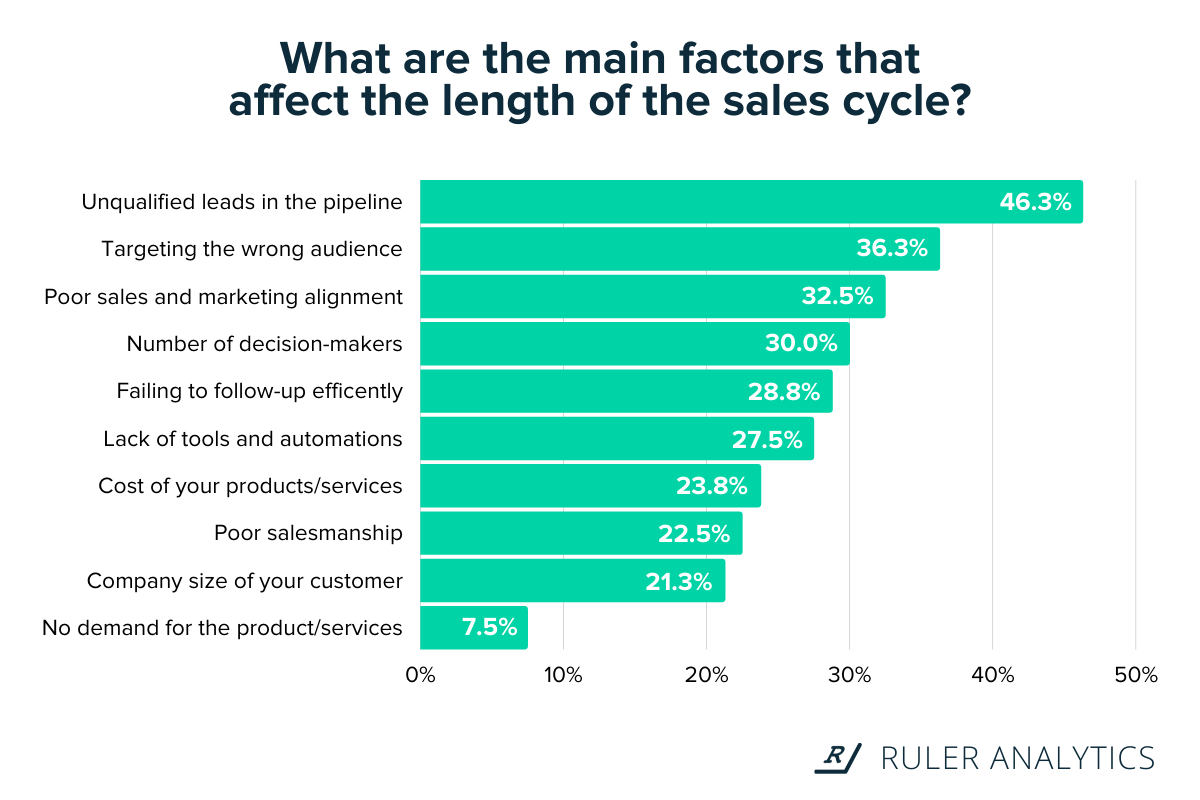
When asked to list the main factors that affect the length of the sales cycle, our respondents ranked the top three as “too many unqualified leads (46%)”, “targeting the wrong audience (36%)” and “poor sales and marketing alignment (31%)”.
Related: A complete guide to sales and marketing alignment
Nearly half of the people we surveyed agreed that too many unqualified, low intent leads in the funnel are notorious for slowing down the speed of the sales cycle.
Having too many unqualified leads overwhelms the pipeline and causes the sales team to overlook and miss out on genuine sales opportunities.
“Representatives should be careful not to waste their time prospecting and chasing up unqualified candidates,” added David Marshall, Founder at Performio.
Next in the order is targeting the wrong audience (36.2%). Businesses who cast the net too wide often end up promoting products and services to people who have minimal (or non-existent) buying intent.
“The wrong audience will always feel bothered by your sales talk and will want to find a way to cut communication,” added Harriet Chan, Co-Founder at CocoFinder.
Last but not least, we have poor sales and marketing alignment.
If your sales and marketing teams are separated, then you’re probably suffering lengthy sales cycles. Sales and marketing alignment has always been a challenge and generally comes down to blindspots caused by missing data in a variety of tools.
Marketing is responsible for driving leads which are then passed onto sales to convert into revenue. Each team will work in different tools to handle these leads, which creates a disconnect.
As a result, the sales cycle gets lengthened, or worse, stopped.
“Long sales cycles have always existed and reducing the cycle time should always be the goal,” says Aaron Pook, Marketing at TGC Worldwide.
Long sales cycles cause a major headache for many companies, especially those that sell high-end, expensive products and services.
Luckily for us, we had experts at hand to help share the best practices and techniques to reduce the sales cycle.
1. Target the right audience
2. Continuously improve your buyer profile
3. Define your sales process
4. Benchmark your sales cycles
5. Manage the sales process with a CRM
6. Eliminate any manual processes
7. Invest in automation software
8. Score leads in your pipeline
9. Prioritise easy to close leads
10. Nurture leads that aren’t ready
11. Identify your KPIs
12. Lower lead response times
13. Make information accessible to your buyers
14. Identify bottlenecks and stalling issues
15. Focus more on well-performing channels
16. Keep your pricing transparent
17. Avoid or limit free trials
18. Leverage team-based selling
19. Create co-urgency with your buyers
20. Use chatbots and live chat
21. Uncover your prospects pain points
22. Set a goal for every call
23. Display your social proof
24. Use electronic devices for contract signing
25. Create a well-segmented email list
26. Hire better sales reps
27. Let buyers buy without over imposing
Let’s dig in.
First and foremost, “You need to have a proper buyer persona so that the lead generation process is accurate,” says Sandeepan Jindal, Founder at BidFortune.
“A lot of times, we end up pitching our product to the wrong point of contact. The product might be useful for them but the decision-maker is usually someone else who manages the end user.”
Targeting the wrong audience can sometimes be worse than having no following at all. Having a lack of understanding for your target audience ultimately leads to budget burnout and slower sales cycles.
Logan Mallory, Marketing VP at Motivosity, recommends taking the time to “understand the key stakeholders and decision makers in your client’s company and form relationships with as many of them as you can.”

“It’s super important to get buy-in at every level to speed up the sales cycle and onboard clients quickier,” added Logan.
As your business grows, you’ll find yourself targeting different audiences. With that in mind, it’s important that you continuously revisit and update your buyer personas.
“Your sales cycle speed can be considerably increased by revisiting and improving your buyer profile,” says Dusan Stanar, Founder at VSS Monitoring.
Dusan suggests the following techniques to update and improve your buyer persona:
Mike Dragan, COO at Stream Live, also commented on this, “You can update the persona by looking at the traits of your prospects that are making real sales. This will provide you with useful information that you can utilise to improve your sales strategy.”
“Too often, sales processes are set, and there’s a point where you put the ball in the prospect’s court and hope they get back to you. The more you can tighten up those gaps, the more it helps truncate the timeline down and leave you chasing and hoping much, much less,” says Zack Drisko, Founder at Rainmakr.
Research has shown that companies with a formal sales process can have 18% more revenue growth than companies without one.
Both Avner Broadsky, Founder & CEO at Superwatches and Polly Kay, Senior Marketing Manager at English Blinds, agree that “developing a good sales lead qualification process to increase your conversion rate” will help speed up the sales process.
There are many techniques you can use to define and manage your sales process. For one, Ruben Gamez, CEO at Docsketch, suggests, “Splitting your sales cycle into different stages and tracking the average time it takes a lead to move from one stage to the next.”

Ruben continued, “Make a list of at least three strategies to speed up the process. Experiment on each and see what is effective. Scale the strategies that are working. After a month or two, repeat the entire process. Speeding up the sales cycle is not a one-off process. It requires constant tinkering.”
Another method is to “look at your entire process from lead generation to closed deal and see if you can eliminate steps,” says Stephen Halasnik, Managing Partner at Financing Solutions.
“We just did a whole revamp with the idea that the faster a lead can become a client, the better our prospects will become clients. Sometimes a business gets used to doing things, and you have to take a look to see if some of those processes are no longer needed and do a revamp.”
“Sales managers must carefully monitor the pipeline in addition to having a well-defined sales process, which is more than just looking at daily and weekly statistics. CRM software allows managers to quickly access the information they need to coach teams and manage pipelines,” says Joe Baker, Founder and CEO at Boots Empire.
The CRM is the best option to manage your sales process, but only if it’s kept organised.
Related: The shifting role of the CRM in marketing
Brian Turner, CTO at Convert Binary, also commented on this, “My tip to reduce and speed up the sales cycle would be routinely clearing up your CRM. Your CRM is effectively a centralised hub detailing the many interactions you have with prospects and customers. As such, it’s pretty important that the information on your CRM is current, factual, and helps you perform your role in converting interest to sales.”
Another effective way to keep on top of long cycles in your CRM is to “align your sales process with the customer journey,” says Oliver Andrews, Owner of OA Design Services.
“You need to know the steps your customers take to make a buying decision. By aligning the sales cycle with the customer journey, your sales team will be able to create a faster and organised flow.”
💡 Pro Tip
Tracking customer interactions across multiple channels unlocks powerful insight which you can use to improve your customer experience and marketing efforts. Get your guide on how to track customer journeys and learn how to follow the complete lifecycle from awareness to decision.
How to track your customer journeys the right way
“Automate the sales process. Not only does this save time on repetitive tasks but also makes the whole sales strategy more effective,” says Jon Buchan, CEO at Charm Offensive. “Without automation, it’s a very lengthy process and involves a lot of hassle.”

The idea of a world without automation is pretty daunting. The number of organisations now using automation technologies has risen from just under half (48%) in 2019 to almost three-quarters (73%) in 2020.
A good place to start is by, “assessing your sales cycle for repetitive operations that sales development reps and salespeople perform to determine what should be automated,” says Adam Garcia, Founder and Owner at The Stock Dork.
Daniel Adams, CEO at Cosier, also pitched in, “Tasks like company information and data entry leads can be easily automated so you can carry out more practical work like engaging one on one with clients.”
To successfully automate data entry and eliminate manual processes, however, you must first…
Teri Shern, Co-Founder at Conex Boxes, and Aaron Agius, Managing Director at Louder Online, have both had great success when it comes to automation tools.
“Using sales tools and automation software, we cut our sales workload by 40%, allowing our sales reps to focus purely on closing the leads,” says Aaron.
Teri added, “Automation has been an excellent tool to supplement the work that our sales team is doing, and I don’t doubt we’ll continue to look at new automation technology in the future to continue to improve the sales cycle.”
Despite the availability of technology, many businesses still rely on manual labour to enter prospect information into databases. “This procedure can take a long time, especially if your sales representatives handle hundreds of leads per month,” says Jason Mitchell, Chief Technology Officer at Smart Billions.
In fact, it’s for this reason why we came up with our solution, Ruler Analytics, to help marketers simplify and automate the process of attributing revenue to lead generation activity.
In a nutshell, Ruler Analytics is a marketing attribution tool that allows you to connect leads directly to revenue. It identifies your website users and tracks their unique journey over multiple touchpoints, allowing you to optimise performance marketing based on value and not just leads.
Ruler helps cut down on time-consuming tasks so that marketing and sales teams can focus on the strategies with the quickest and most profitable sales cycles.
Related: How Ruler attributes revenue to your marketing
Not only do automation tools save time and speed up the sales cycle, but they “also help personalise experiences,” says Mike Hamelburger, CEO at The Bottom Line Group. “Timing can really help with conversion rates, and automation is spot on with using user behaviours and timing when targeting prospects based on their interest, habits or temptations.”
“My number one tip is to score your leads more efficiently. Not every lead is a good one, and they shouldn’t be contacted by your reps immediately,” says Nadiia Shevelieva, Chief Marketing Officer at Trust.
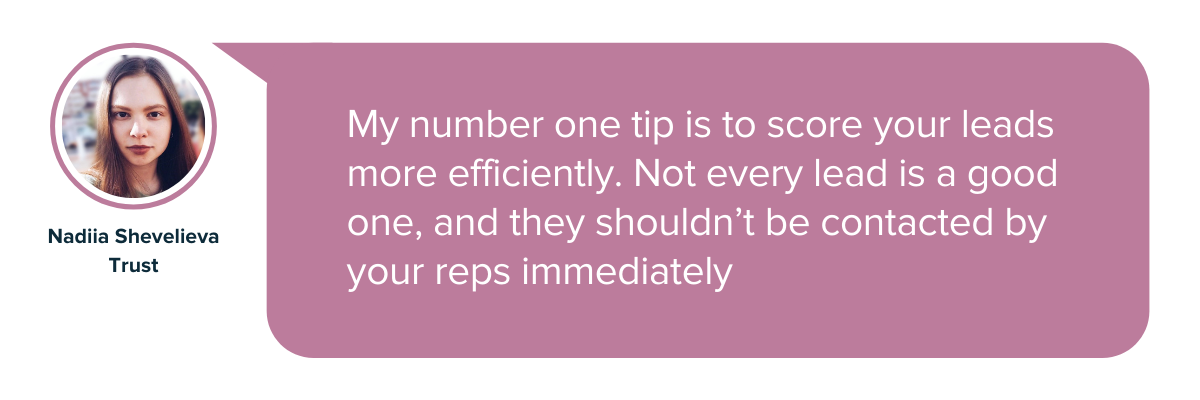
Lead scoring tells you which prospects are worth your time and which aren’t, allowing you to get the most out of your lead generation.
“Your sales pipeline will be accelerated if you evaluate leads as they come in,” says Ben Richardson, Director at Development Academy. “I’d stress the necessity of reps being trained to qualify consumers before putting them in the pipeline. The pipeline will be tighter, but sales will increase. Your salespeople will spend less time chasing rubbish and more time working on real deals.”
“One of the best ways to speed up your sales cycle is to stop wasting your time and money on unqualified leads that can’t be converted into active customers,” says Cale Loken, CEO at 301 Madison Consulting. “There is no use focusing on these leads. They’ll do nothing for your business other than slowing down the speed of the sales cycle.”

It’s easy to assume that more leads are the answer to lower sales cycles, but it’s quite the opposite. As we discussed earlier, having too many unqualified leads floods the pipeline and slows down the effectiveness of your sales team.
Chris Taylor, Marketing Director at Profit Guru, suggests “prioritising the leads you want to close first” to help accelerate the sales cycle.
“You may achieve this by asking leads how quickly they want to seal the transaction while you’re on the phone with them. Similar timeline-related queries are typical practices, and they naturally lead to more queries about the lead’s needs. You’re more likely to shorten the sales cycle if you prioritise such leads.”
Willie Greer, Founder of The Product Analyst, agrees that you should, “Learn to prioritise what leads are easier to close.”
You can “ask the leads how soon they are to close the deal. Prioritising the easier ones, will decrease the sales cycle timeframe,” Willie added.
As we’ve just discussed, not every lead generated is sales-ready. Having a process to nurture leads allows you to stay engaged with people who may eventually convert into a customer further down the line.
“It’s okay if not everyone makes it to the end of your sales cycle. There could be a variety of reasons why qualified leads didn’t quite make it, including landing page pollution and insufficient staff support. But it’s pointless to concentrate on them,” says Lacy Summer, Chief Marketing Officer at Crush the PM Exam.
Alex Claro, VPN Analyst at Credit Donkey, suggests, “Making a separate list for casual browsers and those who are unlikely to buy in the future. These should be treated as leads to be fostered and help salespeople to focus on well-qualified prospects, which speeds up pipeline sales.”
“One of the best tips to reduce and speed up the sales cycle is to benchmark your cycle times,” says Edward Mellett, Founder at Wikijob.co.uk.
“Start tracking the average time it takes to go from prospecting to closing once you’ve established a reliable sales process. From here, you can continue to improve your baseline and establish new goals for your team to achieve. You can also minimise the average time by optimising lengthier individual phases.”
💡 Pro Tip
Discover which marketing channels have the highest conversion rates across 14 industries and help speed up your sales cycles. Download the conversion benchmark report to get started.
Benchmarking your performance gives you a competitive advantage and allows you to set more meaningful and achievable targets. However, it’s important not to get too hung up on what your competitors are doing.
“Many sales managers may be tempted to compare themselves to their competitors after seeing the results, but this is not recommended,” says Darshan Somashker, Founder and CEO at Spider Solitaire Challenge.
“Factors unique to each organisation, such as geography, product line, and sales strategy, might influence the average sales cycle. Instead, you might be better off utilising the average length of your sales cycle as a comparison. It can be used to determine whether the adjustments you make are effective.”
Once you have a rough idea of the length of your sales cycles, you’ll need to set some goals and kpis to help keep you on track.
“You’ll need to develop KPIs that track how long leads take to travel from one step of the pipeline to the next,” says Pranchil Murray, Head of Customer Success at Malwarefox.
The following are some examples of KPIs:
“Your sales cycle will be shorter if these methods are more productive. Determine your key performance indicators and set a goal for each one. This should provide your salespeople with a clear understanding of what’s expected of them, allowing them to move deals through the pipeline quickly,” added Pranchill.
Related: 22 sales pipeline metrics recommend by the experts
Naomi Bishop, Chief Insurance Officer at Surfky, suggests “setting aside time each week to review your sales data. Determine the most essential KPIs for your company and closely monitor them. You may notice that deals that start with a phone call and end with a demo close 50 percent faster than offers that start with an email. In such a situation, you’ll want to keep an eye on how many phone calls your staff are making and devise methods that can handle a higher volume of calls.”
Lowering your lead responses times should be at the top of your list of KPIs when measuring and reducing the length of your sales cycle.
Tal Shelef, Co-Founder at CondoWizard and Miranda Vinpit Yan, Co-Founder at VinPit, both believe, “The best way to reduce the sales cycle is by lowering your lead response time.”

“Customers are more likely to buy from companies that respond to their concerns first. Setting your foot in the door earlier than others will give you an edge,” added Tal.
When looking to buy a service, a lead will contact three to five companies and 50% of purchasers will choose the vendor who responds to their request first. In addition to this, a survey of 433 businesses found that only 7% of them reply to incoming inquiries within five minutes.
“Quickly connecting with the customers allows them to consider you as one of the alternatives in their buying decisions,” says Shakun Bansa, CMO at Mercer.
“Have a streamlined alignment between your marketing lead generation teams, sales development teams, and sales professionals. Pass the leads quickly, understand the customer requirements in-depth, follow up continuously and negotiate, and offer them the best price to convert them successfully,” added Shakun.
An effective way to reduce your response times is by “giving your prospect information in advance shows your knowledge and reduces the number of touchpoints needed to close, ” says Patrick Carver, Chief Marketing Officer at Constellation Marketing.
John Webster, Managing Director at Wiringo, agrees, “If a buyer has their questions answered and understands what you’re selling before they come in for an appointment, then that gives them time to think about whether your business is right for them or not.”
“My number one tip to reduce and speed up the sales cycle is to locate the bottlenecks,” says Lily Ugbaja, Founder at Dollar Creed. “This means finding out how long it takes for a customer to convert and the time spent on each stage of the sales cycle. This allows you to gauge whether your sales are moving through the funnel, plus what should be improved to shorten the time.”
Janet Patterson, VP of Marketing Communications at Highway Title Loans, also points out that: “You need to carefully observe the time it takes for one deal to process from one stage to another. If your company deals stall more in the introduction stage, then it is an indication that the company struggles with client commitment. You can start by using google calendar to schedule your meeting with the clients, follow that up with a call, and eventually a follow-up email if you do not get a reply within 48 hours.”
“You should focus and invest more on the channels that generate more leads and convert into customers, and let go of the non-productive ones.” says Scott Williams, Digital Marketing Analyst at MobileOfficeSales.com. “This will save you money and speed up your sales cycles as you won’t be wasting your time on channels that do nothing for your company.”

Steve Scott, CTO at Spreadsheet Planet, agrees, “Channels that fail to provide quality cases should be removed from your sales process as soon as possible. They are a waste of time and money that does not provide a good return on investment.”
In order to focus on easy to close leads, you’ll need to identify your best performing sales and marketing channels.
Christian Velitchkov, Co-Founder at Twiz LLC, suggests that you: “Keep a check on how all your channels are performing. Having multiple channels might help reach a wider audience, but after a certain period, some of these channels might go cold. There is various software available that can help you derive precise analytics for the performance of your channels. It shows you which channel is gaining the most and the least attention from the audience. It shows you which of your customers are still actively engaged with your channel.”
Ruler is a good example. With Ruler’s marketing attribution functionality, marketers can evidence every step a visitor makes in their journey and match CRM revenue directly back to the marketing source through the lens of different attribution models.
💡 Pro Tip
Want to learn more about Ruler? Get our comprehensive guide on Ruler and see how it can help boost the quality of your marketing reports with multi-touch attribution data.
Why you need Ruler
Once you find and scale the lead-generation channels that convert the most qualified leads, Sam Browne, CEO at Find a Band, recommends that you: “Label all of your closed deals with the channel from which they came, and then sort by the number of days it took to close each lead. It’s crucial to keep in mind that the same channels may not always provide you with the best closing leads. Good leads may begin to come in from different sources over time, so it’s critical to keep track of all your lead creation channels.”
“Be upfront about your pricing early on in the process, so prospects aren’t caught off guard. Prospects who are taken aback by unexpected costs or fees will cause the sales cycle to slow down,” says Jason McMahon, Digital Strategist at Bambrick.
It’s not uncommon for businesses to attract and engage prospective buyers by offering lower pricing and deals during the initial stages. While it’s proven to help people get in the door, increasing prices, later on, can very often drive away sales opportunities.
Devin Jonhson, CEO at Kennected, agrees, “Though it’s tempting to make costs seem as low as possible to attract more leads, pricing transparency is a great way to build client trust and suss out sooner whether the conversion is viable.”
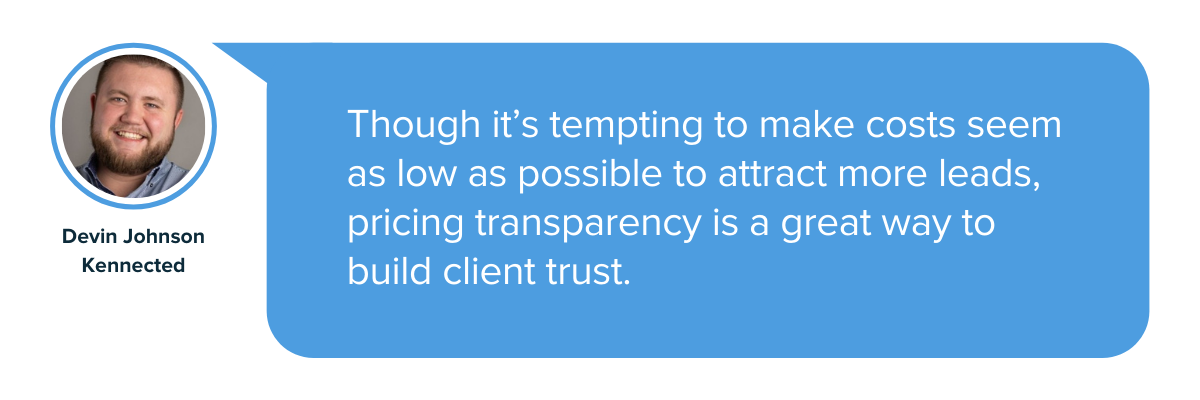
Julian Goldie, CEO at Goldie Agency, suggests that: “You should emphasise the benefits over cost and not surprise the prospect with the price.”
You should sell product benefits which are backed up with good knowledge and communication skills. “Prospective clients will ignore a salesperson who is too good to be true while offering a pricey product,” says Julian.
John Francis, Founder at RocketForms, and Cody Miles, Founder & CEO at Ashore, both proposed shortening your trial length if you’re in B2B SaaS.
“At RocketForms, we shortened from 30 days to 14 days, then eventually down to 7 days. The impact? Fewer tire kickers and more revenue. While going down to seven days feels uncomfortable, it helped us cut our sales cycle by more than 2X,” says John.
Cody also chimed in, “Initially, we offered an unlimited free trial of our app, and like many SaaS companies before us, we realised that wasn’t feasible. People love a free option, and they ended up taking far longer to buy without time constraints. Now, our free trial is capped at 14 days, and it doesn’t come with the full feature set. These small changes have been extremely successful; we’ve now reached over 15,000 creatives worldwide, a feat that would’ve been near impossible without the adjustments we’ve made.”
“Some agreements require a little extra encouragement from the C-suite to convince the prospect to move forward. Those executives are the most knowledgeable about the product’s subtleties, problematic areas, potential hacks, and general use cases. For difficult issues about code implementation or APIs, bringing in a technical founder or VP-level executive might be very beneficial,” says Sasha Quail, Business Development Manager at Claims UK.
Team-based selling is a process that allows sales teams to collaborate on complex deals and close more efficiently.
“Your organisation most certainly has large reserves of information just waiting to be accessed, and utilising those resources can turn a delayed deal into a satisfied customer,” says Daniel Foley, SEO Manager at Litta.
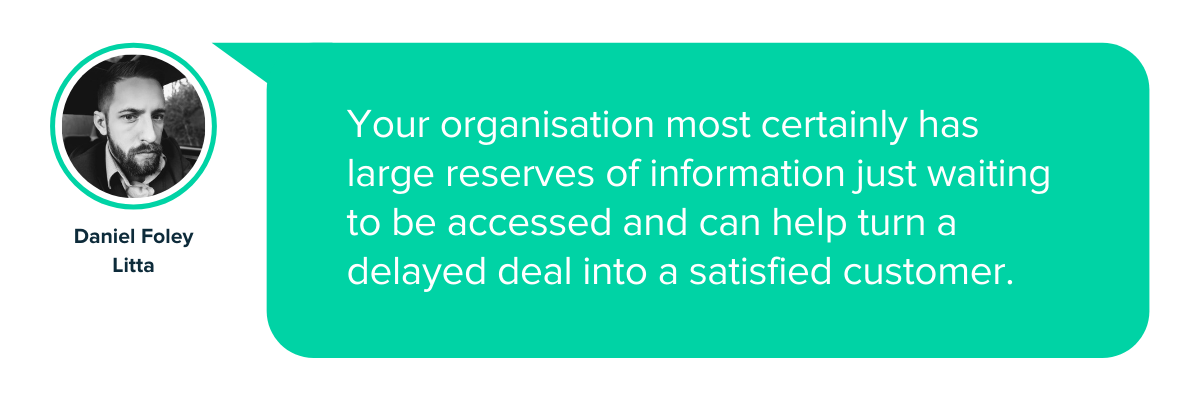
Daniel suggests, “Creating a special channel of communication (like Slack) for the complicated deals and invite anyone who might be able to help. Update the channel as new information on the deal becomes available, and push everyone involved to contribute their knowledge.”
“Our number one tip for reducing the lengthiness of the sales cycle is centred in messaging. Creating a sense of urgency helps get you in the door,” says Adam O’Leary, President at Encite International.
Creating a sense of urgency allows you to close the sale faster and with less effort. In fact, Marcus Taylor saw a 332% uplift in sales by increasing the amount of scarcity and urgency.
Christian Bolz, Founder at Coara, suggests that you should: “Find out early on in the sales cycle how a customer wants to buy from you and when they need to have the product or service in place. Work a buying project plan backwards to the point where they have to say yes to meet their implementation deadline. They communicate their implementation deadline, and you tell them when they need to buy to make that happen. You co-created urgency together, and you’ll speed up the sales cycle.”
“Brick-and-mortar stores typically have shorter sales cycles than online stores because they have in-store customer service at hand to answer any questions and provide further information on request.
Online stores can offer a similar customer experience using chatbots and live chat. A combination of chatbots and live chat will have you covered 24/7 and enssure your customers always get the information they need to make a purchase,” Arthur Iinuma, Technology Consultant at ISBX suggested.

Thilo Huelimann, Chief Technology Officer at Levity.ai, agrees, “Live Chat is great for eCommerce sites because you’re covered 24 hours a day, seven days a week.” And believes “chatbots are a great alternative if you don’t have the resources to handle live chat.”
Related: How to track live chat conversions in Google Analytics and drive more targeted sales
Live chat is a great way to provide real-time support and speedy solutions that help move customers through the sales funnel more efficiently. Mainly because “chatbots improve customer experience, generate more leads, and build a deeper rapport with buyers,” says Onah Natividad, Demand Generation and Digital PR Specialist at Thrive Agency.
Sebastian Schaeffer, CTO and Co-Founder at dofollow.io, in particular, “noticed stark differences in both conversion rates and times when using chatbots and real people.”
“One or more of your marketing demographics may be fine with customer service AI, but the majority of people want to be able to have a real conversation with someone at your company, and they especially don’t like AI that feigns humans, ” Sebastian added.
💡 Pro Tip
Track which channels, campaigns and keywords generate the most valuable live chat conversions and make informed decisions to drive more qualified leads and sales.
How to track your live chat leads and revenue
“Social proof can assist you in establishing credibility and authority to dispel any doubts that your leads may have,” says Tanya Zhang, Co-Founder at Nimble Made. “Case studies and testimonials from well-known brands serve as social proof. They help you gain consumer trust and drive leads through the sales cycle more quickly.”

Posting reviews on your website and social media networks will provide consumers with the verification they need to commit to your business.
Andrew Chornyy, Ideologist and CEO at Pierdy, encourages companies to “not be afraid to employ user-generated content (UGC). Make sure that favourable feedback from your loyal customers appears on Trustpilot, Google, and Yelp. Encourage your customers to make short movies about their interactions with your product. You’ll be golden if you take advantage of every opportunity to demonstrate the value you’ve supplied your consumers.”
“Many salespeople make generic, one-size-fits-all pitches without taking the time to learn about their prospects’ situation. This prevents them from gathering essential information that would allow them to build and fine-tune offers and win over more prospects.
It’s critical to actively listen to your prospects, to hear their problems and complaints. With a few more questions, you’ll uncover the holy grail of successful selling: your prospect’s actual pain points and requirements,” says Miklos Zoltan, CEO & Cybersecurity Researcher at Privacy Affairs.
“When speaking with prospects, make the most of your time by establishing and agreeing on a clear aim for the contact. When you’re on the same page, you’ll only talk and act in ways that will help you get there,” says Sep Niakan, Managing Broker at Condoblackbook.

Sep continued, “For example, if you’re on a discovery call, you might offer to discuss for 15 minutes the prospect’s present system and future expectations. This will serve as a conversational guardrail, allowing you to notice when things go off track and prevent you from revealing worthless information. You can confirm that the objective was met at the end and then set up the following session.”
“Many businesses continue to make one crucial mistake. They don’t make it easy for prospects to sign their contracts using devices,” says Phil Crippen, CEO at John Adams IT.
“Sales teams must adjust to modern buyer behavior when refining their sales techniques. Companies should bid farewell to the days of physical contracts. This is a crucial strategy for accelerating the sales cycle, as it cuts down on back-and-forth between salespeople and customers.”
Christopher Moore, Chief Marketing Officer at Quiet Light, believes that, “Many delays stem from customers having to import the contract into an editing software or having to print it, sign it, scan it and then send it back. If you make it easy to sign the sales contract digitally from any device you eliminate all of these delays.”
“By creating segments, you can send more targeted emails with added personalisation elements, which can speed up the ‘warm-up’ phase that your customer goes through to get accustomed to your brand,” says Nikita Chen, Founder at LegitGrails.
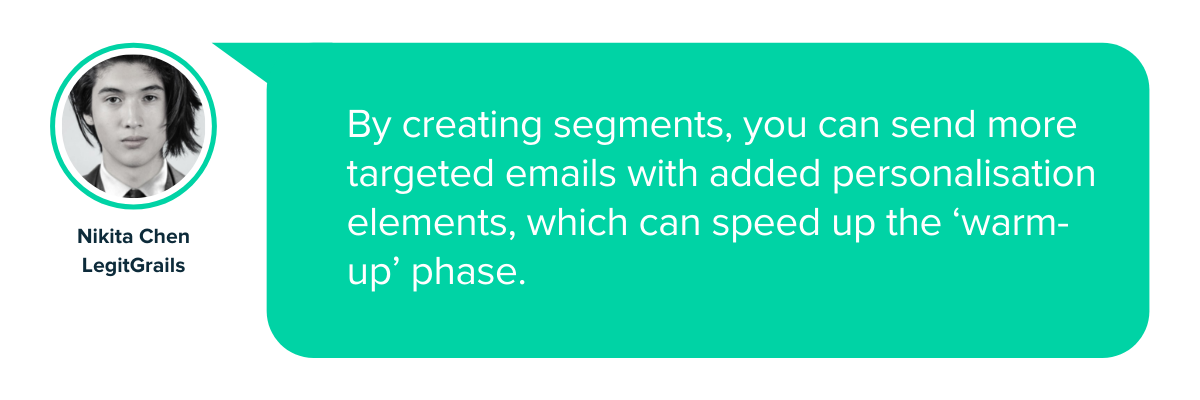
Bryce Welker, CEO at CPA Exam Guy, chimed in, “Your subject line should immediately communicate value, the opening sentence should be personalised and avoid coming off as cloying or insincere, and you should avoid marketer speak throughout the body of the email.”
“When making a recruiting decision, consider going beyond whether or not the candidate has a proven record of meeting quota. A strong product and a terrific team can frequently make a salesperson appear more impressive than they are.
“Rather, look for reps who are persistent, coachable, composed, and self-motivated. Focus on enthusiasm, passion, and cultural fit first and foremost. The most effective reps are those who believe in your product, collaborate well with their colleagues, and are ready to go above and beyond to keep the prospect satisfied,” says Ryal Dalal, CEO & Founder at Merge PDF.
“Buyers are doing a ton of self-directed research on search engines, review websites, and social media websites. Most don’t want to speak with a salesperson until a big portion of their research and decision-making is done”, says Joshua Feinberg, CEO at SP Home Run Inc.
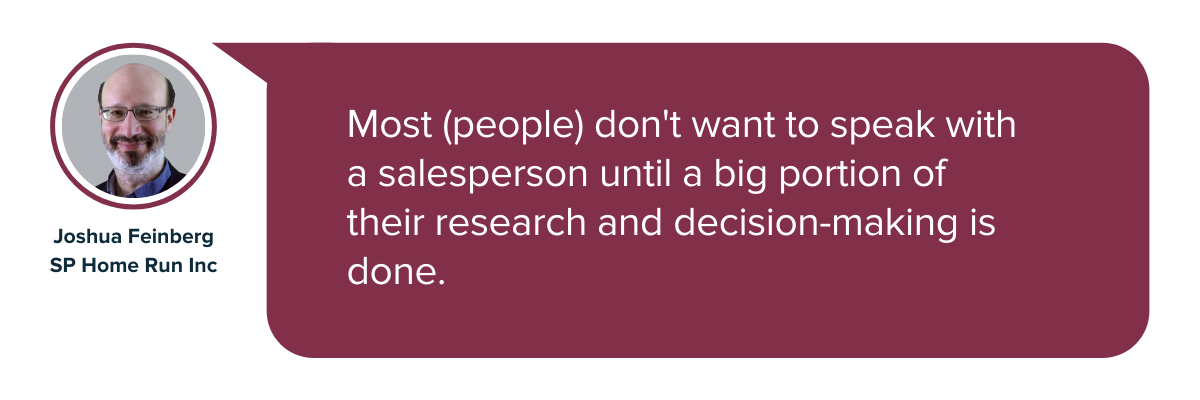
Joshua continued, “Many sales organisations refuse to accept that reality and force prospects to audition for the privilege of talking to a real salesperson, for the privilege of learning about pricing and options. It’s madness. This outdated thinking just elongates the sales cycle.”
On the other hand, “It’s important not to be afraid to close or attempt to move a prospective buyer towards striking a deal,” says Nathan Murphy, Co-Founder at Quizbreaker.
Sales representatives need to give prospects enough room to make their own decisions but also need to be there to keep important deals moving forward.
You can have an established product, but if your sales cycle is too long, then you will end up having cash flow problems,” says Evan Tzivanaks, Founder and Executive Coach.
Evan summarises the techniques in this post which you can use to increase your sales cycles:
By honing in on the steps above, you can free up extra time for salespeople to bring on more sales and watch your bottom line flourish.
Reuben Yonatan, Founder & CEO at GetVoIp, leaves us with this: “Focus on what you know works, cut the rest, and be thoughtful when it comes to expanding your message.”
